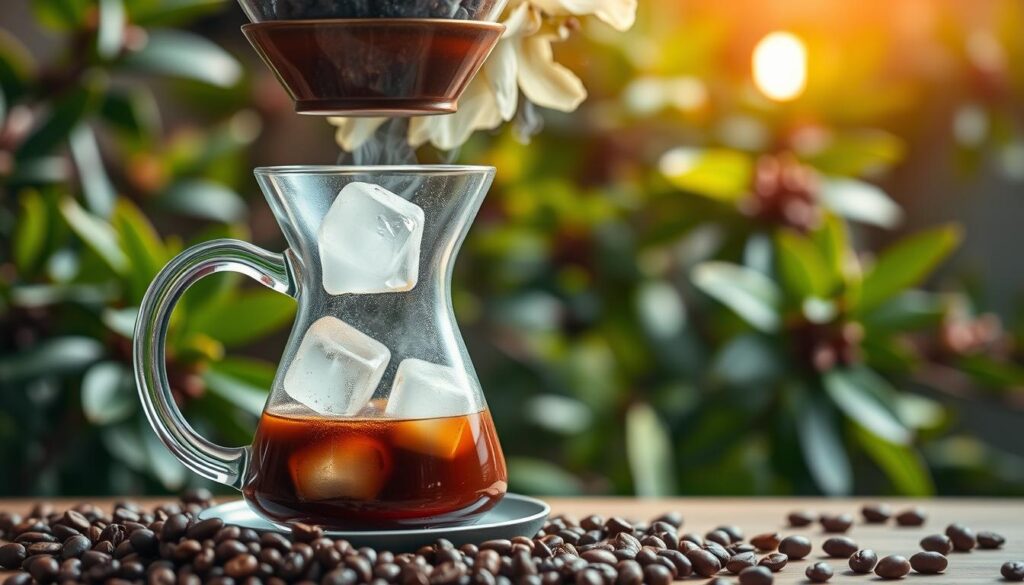Summer heat makes us crave a cool, refreshing iced coffee. It’s more than just hot coffee over ice. Making the perfect cold brew needs skill, knowledge, and love for coffee.
Cold brew and iced coffee are now loved all year, not just in summer. With new brewing methods and coffee tricks, anyone can make their cold coffee amazing. This guide will show you how to make an iced coffee that’s truly special.
We’ll explore different brewing ways, tools, and how to make it taste better. Whether you drink coffee sometimes or all the time, these tips will change how you make iced coffee.
Key Takeaways
- Cold brew needs special techniques, unlike hot coffee
- Water quality and coffee bean choice greatly affect taste
- The right brewing temperature is key for flavor
- Good equipment can make your iced coffee better
- Trying new things helps you find your favorite way to brew
Understanding the Magic Behind Cold Coffee Brewing
Cold extraction changes how we enjoy coffee, revealing a unique brewing method. It unlocks hidden flavors and nuanced characteristics. Unlike hot brewing, cold extraction offers a distinct coffee experience that many coffee lovers now prefer.
The Science of Cold Extraction
Cold extraction is a careful brewing method. It involves steeping coffee grounds in cold or room temperature water for a long time. This gentle method allows for a different interaction between water and coffee compounds:
- Slower extraction reduces bitter compounds
- Preserves delicate flavor profiles
- Creates smoother, less acidic coffee
Temperature's Effect on Coffee Compounds
Temperature is key in coffee extraction. Hot water quickly pulls out compounds like bitter and acidic elements. Cold extraction, however, slowly extracts coffee’s complex flavor molecules. This results in a remarkably different taste experience.
“Cold brewing is like a gentle whisper, while hot brewing is a loud conversation.” – Coffee Expert
Why Iced Coffee Tastes Different
The flavor of cold-extracted coffee is unique compared to hot brewed coffee. Cold extraction minimizes oxidation and reduces harsh tannic acids. This creates a smoother, more nuanced beverage that showcases the bean’s true characteristics.
- Less bitterness
- Enhanced natural sweetness
- Clearer representation of bean origin
By understanding cold extraction’s science, coffee lovers can appreciate the detailed process. It transforms simple coffee grounds into a refreshing and sophisticated drink.
Essential Equipment for Iced Coffee Excellence
Making the perfect iced coffee begins with the right gear. Whether you love coffee or are a cold brew pro, the right equipment makes a big difference. It can change how you brew coffee at home.
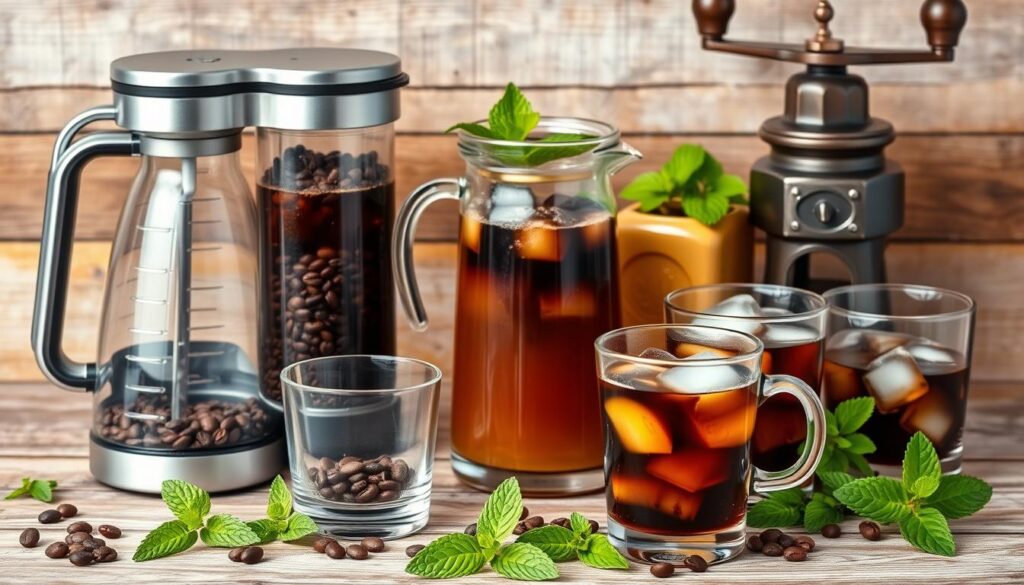
Exploring cold brew means getting the right tools. These tools can take your coffee to the next level. Here are the must-haves for every coffee lover:
- Cold Brew Maker: A dedicated vessel for smooth extraction
- High-Quality Burr Grinder: Ensures consistent coffee ground size
- Fine Mesh Filters: Prevents sediment in your final brew
- Glass Storage Containers: For storing and preserving cold brew
When picking coffee gear, choose quality for lasting results and durability.
| Equipment Type | Purpose | Recommended Investment |
|---|---|---|
| French Press | Versatile Cold Brew Method | $25-$50 |
| Dedicated Cold Brew Pitcher | Specialized Brewing | $30-$75 |
| Ceramic Burr Grinder | Consistent Ground Size | $100-$200 |
Pro tip: Stainless steel and glass containers are best for keeping cold brew flavors fresh. Plastic can add unwanted tastes to your coffee.
With the right cold brew equipment, you can make cafe-quality iced coffee at home.
Selecting the Right Coffee Beans for Cold Brewing
Cold brewing turns regular coffee beans into a smooth, refreshing drink. The right coffee beans can make your iced coffee truly special. It’s important to know how to pick the best beans for a great cold brew.
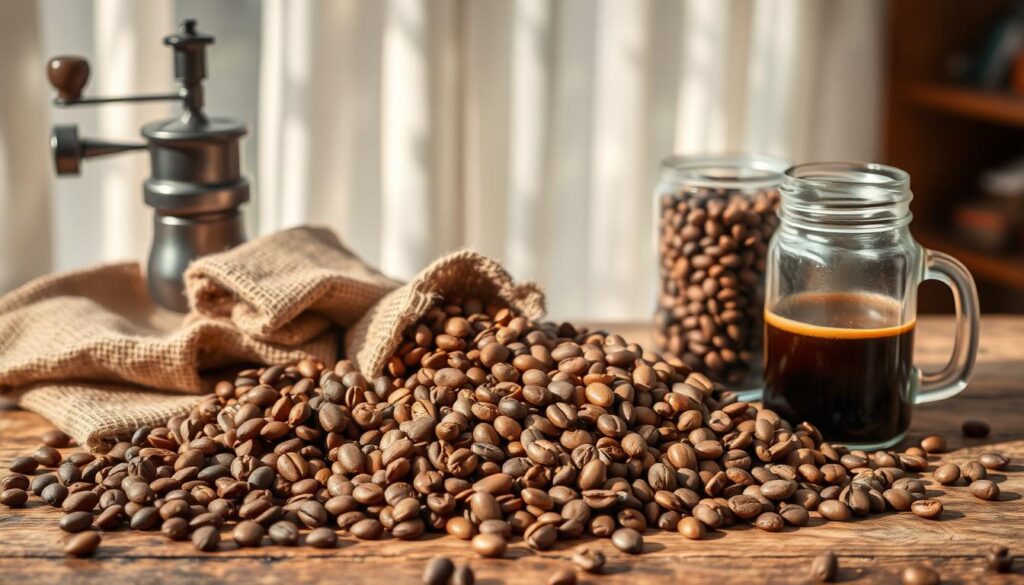
Single Origin vs. Coffee Blends
There are two main types of coffee beans for cold brewing: single origin and blends. Single origin beans come from one place, offering unique flavors. These beans show off the taste of their specific region.
- Single origin beans: Highlight individual terroir characteristics
- Coffee blends: Combine multiple bean types for balanced flavor
Roast Levels for Cold Brew Perfection
The roast level of your coffee beans greatly affects the taste of your cold brew. Medium to dark roast beans are best for cold brewing. They bring out rich, bold flavors during the brewing process.
“The right roast can transform your cold brew from ordinary to extraordinary.” – Coffee Enthusiast Magazine
Masterful Bean Storage Techniques
Keeping your coffee beans fresh is key. Store them in an opaque, airtight container away from sunlight, heat, and moisture. Whole beans stay fresh longer than ground coffee, perfect for cold brewing.
- Use airtight ceramic or glass containers
- Store in cool, dark locations
- Avoid refrigerator storage
- Purchase smaller quantities for maximum freshness
Pro tip: Buy whole beans and grind them just before brewing. This way, you get the most flavor in your cold brew.
Water Quality and Ice: The Hidden Components
Making the perfect iced coffee is more than just picking great beans. The water you use is key to the taste and feel of your cold brew. Baristas say that mineral content and filtration change how coffee tastes.
The water you pick affects how coffee compounds are extracted. Tap water has minerals and impurities that can mess with the flavor. To get a clean taste, use filtered water. This lets the coffee’s real taste come out.
“Pure water is the canvas on which coffee flavors paint their masterpiece.”
Key Considerations for Water Quality
- Use filtered water with balanced mineral content
- Avoid distilled water, which lacks essential minerals
- Test your water’s pH and mineral composition
- Consider using spring water for optimal results
Ice cubes are also important but often ignored. Regular ice can add bad tastes and water down your coffee fast. Making clear, pure ice cubes needs careful filtering and freezing.
Ice Cube Brewing Tips
- Use filtered water for ice cube preparation
- Boil water before freezing to reduce air bubbles
- Freeze in shallow, clean containers
- Store ice in sealed containers to prevent absorption of refrigerator odors
Pro tip: Investing in quality water filtration can elevate your iced coffee from good to exceptional.
The Art of Iced Coffee: Hacks for the Perfect Brew
Creating the perfect iced coffee is more than just adding ice to your regular coffee. Coffee lovers know that the right brewing techniques can change your cold coffee game. Baristas have special tricks that make iced coffee truly stand out.
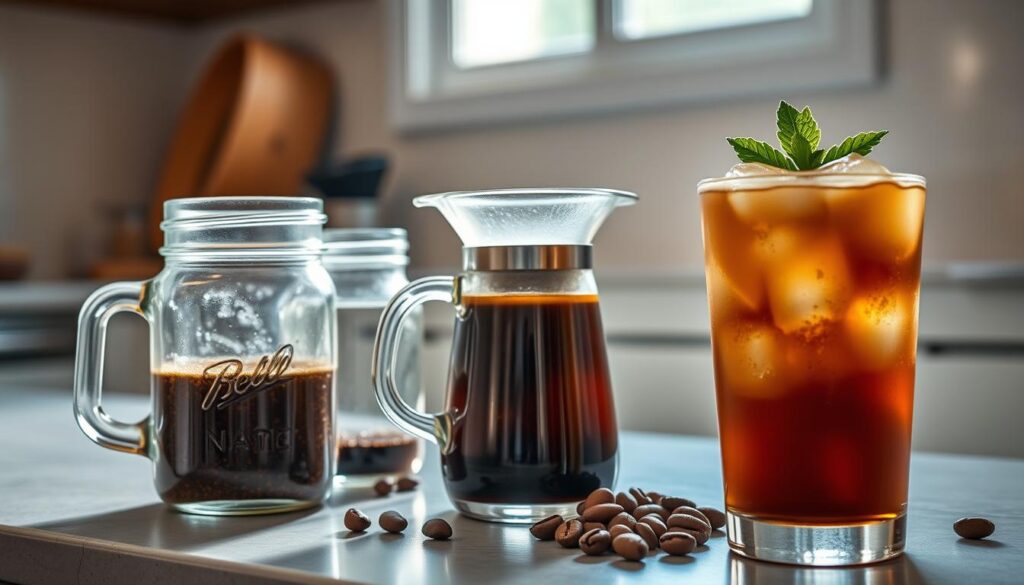
The key to amazing iced coffee is knowing how to manage temperature and dilution. Let’s dive into some pro tips that will change how you make cold coffee.
Pre-Chilling Techniques
Great cold brewing starts before you start brewing. Coffee experts suggest these pre-chilling steps:
- Freeze coffee in ice cube trays to prevent dilution
- Chill brewing equipment beforehand
- Use filtered water at precisely 40-45°F
Dilution Control Methods
Keeping the flavor strong in your iced coffee is key. Here are some strategies:
- Use a concentrated coffee base
- Measure ice-to-coffee ratios carefully
- Try special brewing methods
Timing and Temperature Control
“Perfect iced coffee is a delicate dance of time and temperature.” – Specialty Coffee Association
Getting the temperature right is crucial for the taste of your coffee. Think about brewing time, extraction temperature, and cooling methods. Try different methods to find your perfect brew.
Learning these coffee hacks will make your iced coffee go from good to great. Every sip will be perfectly balanced and refreshing.
Popular Iced Coffee Brewing Methods
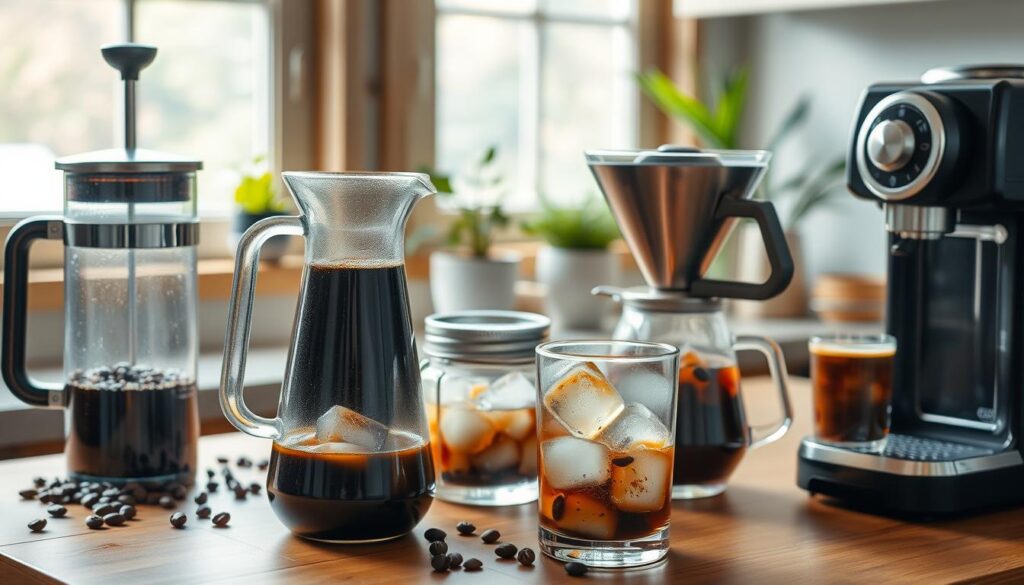
Coffee lovers have come up with many ways to make the perfect cold coffee. Each method gives your iced coffee its own special touch. It turns regular coffee beans into amazing drinks.
Cold brew is a favorite among coffee fans. It involves soaking coffee grounds in cold water for 12-24 hours. This makes a smooth, less acidic coffee that’s perfect for hot days.
- Cold Brew: Slow steeping method
- Japanese Iced Coffee: Quick brewing technique
- Flash Brew: Rapid cooling method
Japanese iced coffee is a different story. It’s made by brewing hot coffee right onto ice. This method keeps the coffee’s flavors fresh and complex.
“The secret to exceptional iced coffee lies not just in the beans, but in the brewing technique.” – Coffee Master
Flash brew is a mix of cold and hot brewing. It brews coffee hot and then cools it down fast. This makes a drink that’s both crisp and full of flavor.
| Brewing Method | Brewing Time | Flavor Profile |
|---|---|---|
| Cold Brew | 12-24 hours | Smooth, Low Acidity |
| Japanese Iced Coffee | 3-4 minutes | Bright, Complex |
| Flash Brew | 2-3 minutes | Crisp, Aromatic |
Knowing about these brewing methods lets coffee fans try new things. They can find their favorite way to enjoy cold coffee. Each method offers a unique way to make a refreshing, tasty cold coffee.
Flavoring and Sweetening Your Iced Coffee
Turning a basic iced coffee into a tasty treat is all about flavoring and sweetening. The right mix can make your cold brew stand out. It becomes a drink that’s all about you.
Natural Sweetener Options
Trying out natural sweeteners can make your iced coffee richer and more interesting. Here are some great options:
- Honey: A pure, unrefined sweetener with unique floral notes
- Maple syrup: Provides a rich, caramel-like sweetness
- Agave nectar: A mild, smooth sweetener with low glycemic impact
- Stevia: A zero-calorie plant-based option for health-conscious coffee lovers
Dairy and Non-Dairy Milk Alternatives
Milk alternatives can change your iced coffee’s feel and taste. Try these to find your favorite:
- Almond milk: Light and nutty, with a subtle sweetness
- Oat milk: Creamy and smooth, ideal for flavor infusion
- Coconut milk: Adds a tropical twist to your cold brew
- Macadamia milk: Rich and buttery, creating a luxurious mouthfeel
Flavor Infusion Techniques
Discover new tastes with creative flavor infusion methods:
- Infuse coffee with cinnamon sticks during brewing
- Add vanilla extract for a classic, smooth flavor
- Blend in lavender or mint for unexpected complexity
- Experiment with spices like cardamom or nutmeg
“The perfect iced coffee is a canvas for culinary creativity” – Coffee Enthusiast Magazine
Remember, the secret to amazing iced coffee is finding the right balance. It’s all about what you like best.
Common Mistakes to Avoid in Iced Coffee Preparation
Making the perfect iced coffee needs skill and precision. Many home brewers face brewing errors that ruin their cold coffee. Knowing these mistakes is key to fixing them and improving your iced coffee.
“The difference between good and great iced coffee lies in avoiding common preparation mistakes.”
Here are the most common brewing errors that can mess up your cold coffee:
- Using Hot Coffee Directly on Ice: This makes your coffee weak and watery right away
- Wrong Coffee-to-Water Ratio: The wrong amount of coffee or water can make it taste bad
- Ignoring Bean Quality: Bad or old beans can ruin the taste
Fixing these problems means understanding the science of cold brewing. Baristas suggest special techniques to solve these issues.
| Brewing Error | Impact | Solution |
|---|---|---|
| Incorrect Water Temperature | Bitter or Sour Taste | Use filtered water at room temperature |
| Over-Extraction | Harsh Flavor Profile | Reduce brewing time |
| Poor Ice Quality | Diluted Taste | Use filtered water ice cubes |
By spotting and fixing these errors, you can make your iced coffee much better.
Seasonal Adaptations and Storage Solutions
Making the perfect seasonal coffee means knowing how temperature and storage affect it. Summer brewing has its own set of challenges. You need special techniques to keep your coffee at its best.
Summer brewing needs extra care to keep your coffee’s flavors intact. The heat can quickly spoil your coffee. So, storing it properly is key to keeping it fresh and tasting great.
Summer Brewing Adjustments
- Use cold water with filtered ice to prevent flavor dilution
- Reduce brewing time to prevent over-extraction
- Experiment with lighter roast beans for smoother summer profiles
Long-Term Coffee Storage Solutions
Good batch brewing and storage can keep your cold brew tasting amazing for longer.
| Storage Method | Duration | Best Practices |
|---|---|---|
| Refrigerated Container | Up to 7 days | Airtight glass container |
| Frozen Storage | Up to 2 weeks | Use ice cube trays for easy portioning |
“Great coffee is an art of preservation and precision” – Coffee Enthusiast Magazine
Pro tip: Always store your cold brew in dark, sealed containers. This prevents oxidation and keeps your coffee’s rich, smooth flavor.
Creative Iced Coffee Recipes and Variations
Take your coffee to the next level with these unique iced coffee recipes. They turn a simple cup of coffee into a refreshing treat. From the classic iced latte to the trendy nitro cold brew, these drinks will excite your taste buds and wow your friends.
Classic and Contemporary Iced Coffee Recipes
- Vanilla Caramel Iced Latte: A smooth blend of espresso, cold milk, and homemade caramel syrup
- Chocolate Frappé: A decadent frozen coffee drink with rich chocolate notes
- Affogato Delight: Traditional Italian-inspired dessert coffee with vanilla gelato
- Nitro Cold Brew: Creamy, nitrogen-infused coffee with silky texture
Each recipe brings a new twist to cold coffee brewing. The secret is using top-notch ingredients and the right preparation.
“Great coffee is an art form, and iced coffee is its most refreshing canvas.” – Coffee Enthusiast
Flavor Combinations and Techniques
| Recipe | Key Ingredients | Preparation Time |
|---|---|---|
| Nitro Cold Brew | Dark roast coffee, nitrogen | 12-24 hours |
| Frappé | Espresso, milk, ice, sweetener | 10 minutes |
| Affogato | Espresso, vanilla gelato | 5 minutes |
Learning these recipes takes time, patience, and a love for cold brewing. Begin with the best beans, try new methods, and feel free to make your own unique iced coffee.
Conclusion
Making great iced coffee is more than just a skill. It’s a fun journey of discovering flavors and techniques. We’ve shown how temperature, bean choice, and brewing methods change your coffee experience.
Crafting coffee takes patience and a love for learning. Every time you brew, you can get better. You might find your favorite is a smooth cold brew or a crisp iced pour-over.
Great iced coffee is about being creative, not following strict rules. Start with the basics, use good beans, and try new things. Your taste will lead you to a coffee that’s just right for you.
Enjoy the adventure of finding your perfect iced coffee. Each cup is a chance to improve, try new things, and enjoy a cool drink that’s all your own.
FAQ
What’s the difference between cold brew and regular iced coffee?
Cold brew is made by steeping coffee grounds in cold water for 12-24 hours. This makes it smoother and less acidic. Regular iced coffee is hot brewed coffee cooled and served over ice. It can taste more bitter and acidic.
How long can I store cold brew coffee?
Cold brew can last up to 7-10 days in the fridge if stored properly. For the best taste, drink it within the first week.
What type of coffee beans work best for cold brew?
Medium to dark roast whole bean coffee is best for cold brew. Use coarse ground coffee for the best flavor without bitterness.
Can I make iced coffee without special equipment?
Yes! You can make cold brew with simple tools like a mason jar, fine-mesh strainer, or cheesecloth. You don’t need expensive equipment.
How can I prevent my iced coffee from becoming watery?
Use coffee ice cubes instead of regular ice. This keeps your coffee strong and prevents it from getting watery as the ice melts.
What’s the ideal brewing time for cold brew?
Brew cold brew for 12-24 hours at room temperature or in the fridge. Longer times make it stronger and more concentrated.
Are there any health benefits to drinking cold brew?
Cold brew is less acidic than regular coffee, which is gentler on the stomach. It has the same antioxidants and health benefits as hot coffee.
Can I make cold brew with different types of milk?
Yes! Cold brew goes well with almond, oat, coconut, or dairy milk. Each adds a unique flavor to your iced coffee.
How much caffeine is in cold brew compared to regular coffee?
Cold brew has more caffeine because it’s brewed in a concentrated way. A standard cold brew has up to 200mg of caffeine per 16-ounce serving. Hot brewed coffee has about 170mg.
What’s the best way to sweeten cold brew?
Simple syrup dissolves easily in cold coffee. Natural sweeteners like honey or maple syrup also work well. For a healthier option, try stevia or monk fruit sweetener.
Share this post: on Twitter on Facebook

